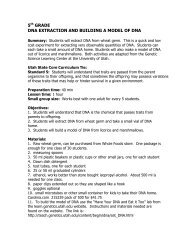Biome Descriptions - Beacon Heights Website
Biome Descriptions - Beacon Heights Website
Biome Descriptions - Beacon Heights Website
Create successful ePaper yourself
Turn your PDF publications into a flip-book with our unique Google optimized e-Paper software.
MOUNTAIN BIOME - INCLUDES TWO SMALLERBIOMESALPINE BIOME - The Alpine biome is found in Utah's highestelevations, above 10,000 ft, where snow and frozen ground arefound almost all year long. The weather is windy and there is muchprecipitation, though most of it in the form of snow. The surfaceterrain is very rocky so plants can not have long root systems.Plants adaptations to the alpine:Low to the ground - this protects them from wind and the loss ofwater through evaporation.Plants are able to grow in rocky or sandy soil.Furry leaves - help protect them from cold temperatures.FOREST BIOME – The Forest biome surface terrain has rich soiland is densely inhabited by plants and animals. There is atemperature fluctuation depending on elevation, different plants arefound at different elevations. Generally, there is enough rain or snowthroughout the seasons to sustain all life.Plant adaptations to the forest:Evergreens like pine, spruce and fir live in cooler temperatures -needles have waxy coating and a small surface area to prevent waterloss.Deciduous trees are tall and have leaves pointed vertically ratherthan flat to avoid direct sunlight during the day when temperaturesare high.Shorter plants live in the shade of taller plants and have large leavesto capture sunlight.
DESERT BIOME - Deserts are very hot during the day and cool atnight. The land is dry, has sandy soil, and receives little precipitation.The surface terrain is sandy with little nutrients in the sand for plantgrowth.Plants adaptations to the desert:Furry leaves - helps minimize water lossSmall, waxy, and thick leaves - helps minimize water lossSpines - minimize water loss and protect the plant from animalsSwollen stems and deep taproots - help store water
WETLAND BIOME - Wetlands are transitional areas betweenwater and land. The land has slow-moving or standing water most ofthe year. In Utah, these may be salty wetlands or fresh waterwetlands. Plants need to cope with the changing water levels. Thesurface terrain is soil that is water saturated. The weather isseasonal with a range in temperatures and precipitation.Plant adaptations to the wetland:Spongy plant tissue that helps plants survive in water by havingmany air spaces that help with buoyancy.Strong stems or floating leaves for a watery environment.Shallow root system or roots that grow above ground since water isadequate.Seeds survive for long times in flood situations.



